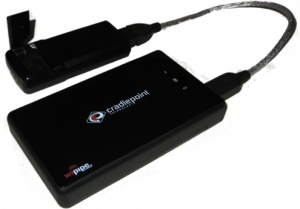
As I posted the other day, my new Cradlepoint PHS300 3G router is just awesome, and I would happily recommend it to anyone. If you do get one, however, be sure to change the default password immediately. The seemingly-strong password is worse than insecure – it’s available to anyone who asks whenever the router is powered on!
Let’s back up, though. When I first set up the router, I was impressed by how simple it was. Turn it on and its Wi-Fi LAN appears almost immediately. Connect to the LAN and your browser is redirected to the router’s management interface (at 192.168.0.1).
I was happy to see that, unlike nearly all router manufacturers, Cradlepoint does not use a default password. Rather, each router has its own unique password – the last six hexadecimal characters of the MAC address, which is printed on a sticker on the bottom of the unit. At the time, this seemed much better than the big manufacturers, which tend to use the easily-guessable “admin” or another short, simple-to-crack word.
But the Cradlepoint also uses the last three characters of the MAC address as its default Wi-Fi SSID. So three of the password’s six characters are broadcast constantly to anyone who cares to see, regardless of whether they are even connected to the LAN! This literally makes the password 4,096 times easier to guess. My router’s SSID was “PHS-28a”, and the password was “02828a” – see the problem? Amazingly enough, though, this isn’t the worst problem!
Most people know that DNS servers translate domain names (like “blog.fosketts.net”) into IP addresses (like “208.113.206.204”). But Ethernet networks (including Wi-Fi) use a different addressing scheme, and IP addresses themselves must be translated into a MAC address (like “00:30:44:02:82:8a”) before it can transmit data. Any connected client can use a command line program called arp to look up a MAC address, which means they can simply ask the router for the MAC thus discover the password. See my password in that example? But wait, it gets worse still!
Cradlepoint suggests setting a connection password, which will keep people from using its 3G connection but will do nothing to prevent them from using arp to find out the router’s password. Smarter people will turn off the SSID broadcast or use a WEP password, which will keep them from connecting to the router’s Wi-Fi network. Although this will stop the arp attack, the password is still vulnerable. See, the address is included as part of every Wi-Fi packet in plaintext, and as any wardriver will tell you, it’s simple to snoop on Wi-Fi packets. So the router is continually transmitting its password, whether one is connected or not. One would need to figure out the WEP password in order to connect, but there are techniques that allow this, and the attacker would then be able to use the administrator password to reconfigure the router.
The Cradlepoint also supports WPA/WPA2, which is much more secure than WEP and would dramatically improve the situation, but not all devices support it. But the real solution is much simpler – change the administrator password to something much more secure. Sadly, most people won’t do any of this – they’ll leave the password as it is and thus leave their router totally open to attack.
But let me just take a moment to beg those who read this post: Don’t ever use a MAC address as a password!
Stephen – thanks for the ideas and feedback. We’ll send it along to our engineering team.